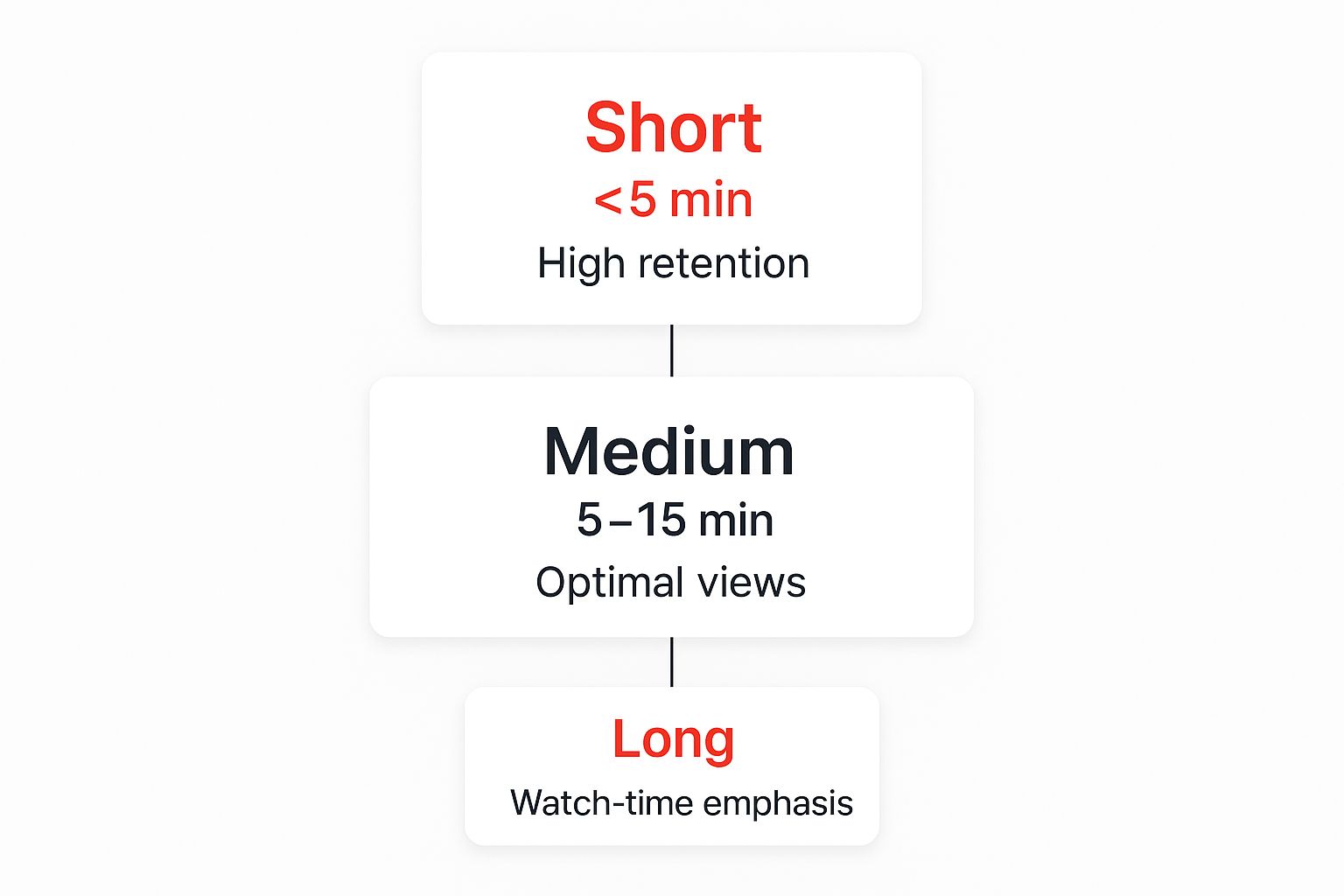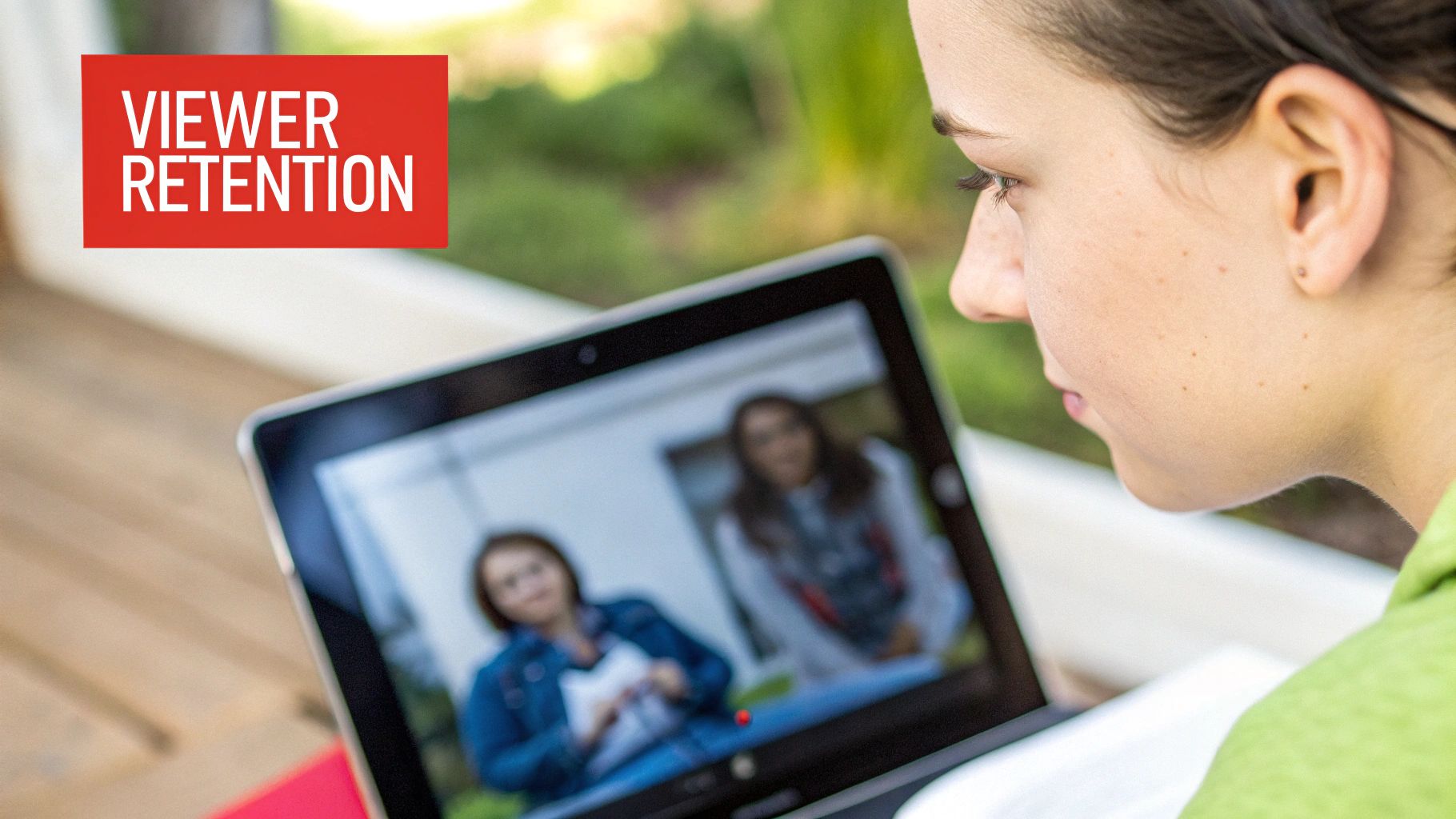The Sweet Spot Revolution: Why 7-15 Minutes Changed Everything

The infographic above shows how YouTube video length affects viewer behavior. It breaks videos down into three categories: short (under 5 minutes), medium (5-15 minutes), and long (over 15 minutes). Notice how short videos are great for keeping people watching, medium videos get the most views, and long videos rack up watch time. This points to that 7-15 minute "sweet spot" – the perfect balance between getting lots of views and delivering meaningful content.
This ideal length wasn’t discovered overnight. Think of YouTube as a massive library. It’s constantly rearranging its shelves based on what’s popular. At first, shorter videos were king – like grabbing a magazine for a quick read. But as people’s viewing habits changed, the library noticed they were spending more time engrossed in "longer novels"—the equivalent of longer videos. This signaled a desire for deeper content, leading YouTube to prioritize videos that held attention longer.
Why 7-15 Minutes Works
For years, research and expert opinions have agreed on this optimal length for YouTube videos. As of 2025, the sweet spot for a YouTube video is still considered to be between 7 and 15 minutes. This range isn’t arbitrary. It comes from both platform analytics and feedback from successful YouTube creators. It's long enough to offer real value, but short enough to avoid overwhelming viewers who might be casually browsing. It’s the Goldilocks length—not too short, not too long, but just right.
To illustrate this further, let's look at different content categories and their ideal video lengths:
Optimal Video Length by Content Type Comparison of recommended video durations across different YouTube content categories
| Content Type | Recommended Length | Average Retention Rate | Best For |
|---|---|---|---|
| Explainer Videos | 5-10 minutes | High (60-70%) | Educational content, product demos |
| Vlogs | 8-12 minutes | Medium (40-50%) | Personal updates, travel diaries |
| Tutorials | 10-15 minutes | Medium-High (50-60%) | Software training, DIY projects |
| Gaming Videos | 12-20 minutes | Medium (40-50%) | Gameplay walkthroughs, reviews |
| Product Reviews | 7-10 minutes | High (60-70%) | Demonstrating features, user experience |
As you can see, while the 7-15 minute range is a good general guideline, specific content types might perform best with slightly shorter or longer videos. The key is to find the right balance for your particular niche and audience.
Benefits for Creators and Viewers
This 7-15 minute window is a strategic win for creators, especially those focused on monetization. It allows for well-placed ads without disrupting the viewing experience. A 10-minute video, for instance, allows for natural mid-roll ad breaks, boosting revenue potential without sacrificing engagement.
Longer videos also create a richer viewing experience. Creators can develop deeper narratives, offer detailed explanations, and build a stronger connection with their audience. This transforms casual viewers into loyal subscribers, driving long-term channel growth and fostering a thriving community.
Understanding the ideal video length is essential for YouTube success. It allows creators to satisfy viewer expectations, maximize ad revenue, and ultimately, build a more impactful presence on the platform. This is especially important for faceless content creators who rely heavily on optimized content strategies. By hitting this sweet spot, creators ensure their content is discoverable, engaging, and profitable. You can find more tips on video length here.
The Algorithm's Journey: From Quick Hits To Deep Engagement

Remember those early YouTube days of bite-sized, three-minute videos? The platform has certainly evolved since then. This isn't just about changing viewing habits; it's about how YouTube's algorithm itself has learned and grown. Initially, the algorithm favored short videos with quick clicks and high completion rates. Think of it like grabbing a quick snack.
But something was missing. While these short videos delivered instant gratification, they didn't necessarily create a deeply satisfied viewer.
Over the past decade, YouTube's approach to video length has shifted dramatically, mirroring changes in audience behavior and platform features. Early on, many creators aimed for short videos, often just 2-3 minutes long, to maximize watch time through high completion rates. However, as YouTube's recommendation algorithms began prioritizing longer viewing sessions and deeper engagement, the average video length increased. More statistics on video length trends are available from Analyzify.
This shift reflects how we consume media in general. You might quickly flip through a magazine, but you'd likely spend hours absorbed in a good book. YouTube recognized this desire for richer, more immersive content.
From Clicks to Connection: The Rise of Engagement
YouTube realized a key principle: longer engagement meant happier viewers and a stronger community. This led to a fundamental shift in how the algorithm evaluated content. Instead of just focusing on clicks, it started rewarding videos that held viewers' attention. This directly impacted the ideal length for YouTube videos.
This wasn't an overnight change, but a gradual evolution. Think of the algorithm as a gardener nurturing a plant. It responded to viewer behavior, cultivating the content that resonated most. YouTube itself became a reflection of this evolving relationship between creators and viewers. Some creators adapted, embracing longer formats and more in-depth storytelling, while others struggled to keep pace.
The Impact on Creators: A New Content Landscape
This shift fundamentally changed content strategies across the platform. Creators had to rethink their approach, moving away from short, quick-hit content towards creating longer, more substantial videos. This wasn't always an easy transition.
Some creators thrived, finding innovative ways to captivate their audiences for longer periods. Others found it challenging to adapt. For creators looking to monetize their content, understanding these shifts is crucial. You can learn more about current YouTube Monetization Requirements. Ultimately, understanding the algorithm's journey is not just about technical details; it's about understanding the evolving nature of online viewership. It's a continuous process of learning, adapting, and creating content that genuinely connects with your audience.
What The Numbers Actually Tell Us About Video Length Success

We've discussed the ideal video length and how YouTube's algorithm has evolved. Now, let's explore the real story behind the numbers: what statistics reveal about video length and success on YouTube. The data offers much more than simple averages; it unveils how diverse audiences, across different regions, engage with content, and what this means for your channel’s growth. It's like uncovering hidden trails on a map, leading to opportunities many creators miss.
Think of it like fishing: you wouldn't use the same bait in a river as you would in the ocean. Understanding regional differences in how people watch videos is crucial for maximizing your reach and engagement. Some audiences might prefer short, dynamic videos, while others might enjoy longer, more detailed content.
The relationship between YouTube video length and audience engagement is multifaceted. It varies based on content type and region, but certain statistical trends emerge. Globally, YouTube boasts over 5.1 billion videos—almost double the number from 2021. Every day, creators upload over 2.6 million new videos, most averaging around 12 minutes in length. SEO.ai offers more detailed insights on these numbers. While this highlights the immense volume of content and the current average length, it's just the tip of the iceberg.
Decoding the Data: Regional Trends and Viewer Preferences
Here's where it gets interesting. Successful YouTubers don’t just rely on global averages; they delve into regional data to understand their specific audience. Like cultural anthropologists, they observe viewing habits and adapt their content accordingly. This is especially important for faceless content creators striving to reach a broad audience. Finding the right length for your YouTube videos can dramatically increase engagement.
You might discover that viewers in one country prefer shorter, fast-paced edits, while those in another prefer longer, more relaxed videos. Understanding these nuances can drastically affect a video’s performance. This leads us to retention rates, a key metric that adds another layer to this puzzle.
To illustrate these regional variations, let's take a look at the following table:
YouTube Video Length Statistics by Region
Data showing average video lengths and engagement patterns across major YouTube markets
| Region | Average Video Length | Top Performing Duration | Viewer Preference |
|---|---|---|---|
| North America | 11.5 minutes | 8-15 minutes | Concise, informative content |
| Europe | 10.8 minutes | 7-12 minutes | Fast-paced, engaging videos |
| Asia | 12.2 minutes | 10-20 minutes | In-depth tutorials and reviews |
| South America | 9.5 minutes | 6-10 minutes | Entertaining, short-form content |
This table showcases how viewer habits and preferences can vary significantly across different regions. These differences highlight the importance of tailoring your video length to resonate with your target audience.
Retention: The Real Measure of Success
While views are a good starting point, retention—how long viewers actually watch your videos—is a far more accurate measure of a video’s impact. It's the difference between someone window shopping and actually buying something. High retention tells YouTube that your content is engaging, which boosts its visibility in search results and recommendations. This can lead to more views, subscribers, and ultimately, a more successful channel.
This deep dive into the data reveals hidden patterns behind why some channels flourish and others stagnate. It’s not about finding a magic number; it’s about knowing your audience, their preferences, and creating content that truly connects with them. It’s about viewing data not as cold statistics, but as a roadmap to building a vibrant community around your channel. This transforms the search for the "best length for youtube video" from guesswork into a strategic advantage.
Mastering Your Niche: Why Gaming And Cooking Need Different Approaches
The ideal length for a YouTube video isn't a one-size-fits-all magic number. It's about understanding your audience and their specific expectations. Imagine trying to force a square peg into a round hole – it simply won't work! Applying the same video length strategy to different content, like gaming versus cooking, is a recipe for missed opportunities.
This screenshot of a typical YouTube homepage shows a variety of suggested video lengths, from short clips to long presentations. This highlights how YouTube caters to diverse viewing preferences, reinforcing the need for creators to tailor their video length to their target audience.
Decoding Audience Expectations: Gaming vs. Cooking
Let's dive into two popular niches: gaming and cooking. For gamers, the sweet spot depends on the content. A highlight reel of exciting moments might be perfect at 5-7 minutes, capturing the thrill without dragging on. Think of these as bite-sized snacks.
But a full playthrough or in-depth tutorial could easily justify 20-30 minutes or more, satisfying viewers who crave deep dives. These are the full-course meals of gaming content.
Cooking videos often shine in the 8-12 minute range. This allows time to demonstrate a recipe from start to finish—ingredients, cooking, and plating—while keeping things concise. Viewers want to learn efficiently, not spend hours watching one dish. It's like a focused cooking class, delivering maximum value in a reasonable time.
Case Studies: Learning from the Pros
Look at successful channels. Popular gaming YouTubers often use a mix of short, impactful highlights and longer, in-depth videos. This caters to different viewing preferences and maximizes reach.
Similarly, successful cooking channels have perfected concise storytelling, delivering complete recipes within a timeframe that respects their viewers’ time.
Consider a cooking channel demonstrating a complex dish. Breaking it into shorter segments within a longer video (a “chunking” method) can improve engagement, making it easy to follow and revisit specific steps.
For gaming, balancing highlights and full gameplay is crucial. Too many short clips might leave viewers wanting more, while too many long playthroughs might scare off casual watchers.
Tailoring Your Approach: Reading the Unspoken Rules
Understanding the unwritten rules of your niche is key. This means analyzing viewer behavior, paying attention to average view durations, and testing different video lengths.
For gaming content, try polling your audience on their preferences for highlights versus full gameplay. For cooking, track viewer retention to pinpoint drop-off points and adjust your pacing.
Finding the perfect length for your YouTube videos is about balancing what your audience wants with the value of your content. It's a continuous process of learning, adapting, and refining based on data and feedback. By understanding your viewers' needs, you can create content that truly connects and builds a loyal following.
Breaking The Rules: When Long-Form Content Becomes Your Secret Weapon
Sometimes, bucking the trend is the smartest move. While many believe shorter videos are the key to grabbing attention online, a growing number of creators are seeing incredible success with videos over 30 minutes long. They're not just defying expectations, they're changing how we think about attention spans and ideal video length on platforms like YouTube.
The Lean-Back Viewing Experience
Think about how people watch TV. They get comfortable, relax, and lose themselves in longer stories. This "lean-back" experience is finding a new home on YouTube. Creators are realizing some viewers want more than just quick snippets; they crave depth and immersion. It's the difference between skimming a headline and getting lost in a good book.
These longer videos aren't just rambling on. They're carefully crafted to keep viewers engaged, often using elements like clear chapters, varied visuals, and compelling storytelling. This turns what could be an overwhelming video length into a rewarding, almost TV-show-like experience, building a unique kind of loyalty with viewers. You might be interested in: How to Make Money on YouTube with Ads.
When Longer Is Better: Understanding Audience Needs
Not everyone wants short, bite-sized content. Some viewers actively look for detailed explanations, in-depth tutorials, and extended discussions. Think about channels covering complex topics like software development, scientific discoveries, or historical analysis. For these audiences, a 3-minute video feels superficial, like barely dipping a toe in the water.
Creators who understand this are building thriving communities around long-form videos. They're not just giving information; they're providing a valuable service, becoming trusted resources, and building real connections with their audience. It's like creating a dedicated learning environment, not just a quick information kiosk.
Structuring for Success: Keeping Long-Form Engaging
Creating successful long-form videos isn't just about making a short video longer. It needs a different strategy, one focused on holding attention over time. Imagine building a skyscraper. You don't just stack bricks higher; you need a solid foundation and a well-thought-out plan.
Here are some key strategies for making long videos captivating:
-
Clear Chapters: Divide the video into manageable sections, each with a specific focus. This lets viewers easily navigate and revisit parts they're interested in.
-
Visual Variety: Use different visuals, like B-roll footage, animations, and screen recordings. This keeps things interesting and avoids monotony.
-
Engaging Storytelling: Weave in stories, anecdotes, and personal experiences to make the content more relatable and memorable.
By mastering these techniques, creators can turn long-form content from a potential pitfall into a major advantage. It's a way to build stronger relationships with their audience and establish themselves as true experts in their niche. This approach gives creators the power to confidently break the "rules" and deliver the kind of substantial content that truly connects with viewers.
Shorts Revolution: Balancing Quick Wins With Long-Term Strategy

YouTube Shorts has undeniably reshaped the content creation landscape. But it's not an either/or situation. You don't have to choose between short, snappy Shorts and your traditional, longer-form videos. In fact, the real magic happens when you blend them strategically.
Think of your content strategy like a Hollywood studio's release plan. Your longer videos are the blockbuster films, rich with story and depth, while your Shorts are the attention-grabbing trailers. Each plays a distinct, yet crucial role in overall success. Let's explore how these formats can work in harmony to build a powerful YouTube presence.
The Symbiotic Relationship: Shorts and Long-Form Content
Forget the idea of Shorts and longer videos as rivals. They're actually allies, working together to grow your audience. Think of your Shorts as a gateway, inviting viewers into the broader world of your channel. A well-crafted Short can spark curiosity and entice viewers to explore your richer, more detailed long-form content. This is especially important for faceless content creators who rely heavily on their content strategy to connect with an audience.
Let's say you have a faceless cooking channel. Imagine creating a visually stunning Short showcasing a delicious finished dish. This quick, satisfying visual treat can then seamlessly lead viewers to a longer video containing the full recipe and step-by-step instructions. It’s like serving an appetizer that whets the appetite for the main course.
From Short to Long: Funneling Viewers Effectively
Shorts offer an unparalleled opportunity to reach a wider audience. Their short, digestible format is perfect for capturing attention in our fast-paced online world. But how do you turn those fleeting Short viewers into loyal long-form subscribers? It takes a strategic approach.
One highly effective method is creating "trailer" Shorts. These showcase the most exciting or intriguing parts of your longer videos, acting like a movie preview. Give just enough to pique their interest and leave them wanting more.
Another powerful tactic is developing series that span both formats. Start a topic in a Short, offering a quick overview or posing a thought-provoking question. Then, direct viewers to a longer video for a deeper dive and more comprehensive explanation. This creates a cohesive content experience, encouraging viewers to explore different facets of your channel.
Building a Channel Ecosystem: Engaging Across Contexts
Successful creators understand that audiences consume content in different ways. Sometimes we crave quick, bite-sized entertainment, while other times we're looking for a more immersive, in-depth experience. By offering both short and long-form content, you cater to these varying needs.
Think of it like a restaurant that provides both a quick lunch menu and a more elaborate dinner menu. This flexibility caters to a wider range of preferences, ensuring everyone finds something they enjoy.
YouTube Shorts also provide a fantastic platform for showcasing different aspects of your channel. Use them for behind-the-scenes glimpses, quick tips, or even humorous outtakes. This adds variety to your content and provides multiple entry points for potential subscribers. By strategically balancing Shorts with traditional videos, you create a dynamic channel ecosystem that keeps viewers engaged and coming back for more. This approach ensures your channel offers something for everyone, cultivating a thriving community of loyal followers.
Beyond Views: The Retention Metrics That Reveal Your True Performance
Views can be deceiving. Like a crowded room, lots of views might feel impressive, but they don't reveal the real story. Retention, however, shows how long people actually stay engaged with your content – it’s the real measure of its impact. Think of views as a headcount at a party, and retention as how many guests are still there at the end of the night.
This section delves into the heart of YouTube Analytics, exploring the data that truly predicts the long-term health of your channel. We’ll move past superficial metrics like view counts and uncover what’s actually happening with your audience. You'll learn how to interpret audience retention graphs like a seasoned investigator, spotting those critical points where viewers lose interest and, even more importantly, why.
Unlocking the Secrets of Retention Graphs
Picture your retention graph as a roadmap of your video's engagement. The peaks and valleys represent fluctuations in viewer interest. A sudden, sharp drop? That’s a red flag. Something at that moment caused viewers to tune out. Perhaps the pacing dragged, or a segment seemed off-topic.
Understanding these patterns is crucial to learning what clicks with your audience and what falls flat. It's like analyzing the plot of a captivating book, identifying the twists and turns that keep readers hooked.
Beyond Retention: Session Duration and Click-Through Rates
Retention isn’t the only important factor. Session duration, the length of time viewers spend on your channel after watching a video, signals to YouTube that your content is compelling. Think of it like a domino effect: one captivating video leads to another, keeping viewers engaged with your channel’s content.
Similarly, click-through rates from suggested videos or end screens tell YouTube that your content effectively guides viewers deeper into your channel ecosystem. This is especially crucial for creators of faceless content, where the content itself is the primary draw.
When balancing short-form content creation with long-term channel growth, understanding ad production speed is essential. This helpful resource on fast turnaround short-form video ads offers valuable insights.
The Ripple Effect: How Video Length Impacts Recommendations
The length of your videos significantly impacts how YouTube recommends your content. Longer videos with high retention signal to the algorithm that you’re providing valuable content, boosting your chances of appearing in suggested videos and search results.
It’s about building trust with the platform. Consistently delivering engaging content, whether short or long, establishes your channel as a dependable source of quality information or entertainment.
The Psychology of Viewership: Understanding the "Why"
Data is informative, but understanding the why behind the numbers is invaluable. Why do viewers disengage at specific moments? What keeps them captivated? This is where understanding viewer psychology comes in.
Grasping viewer behavior patterns can revolutionize your content creation and optimization strategy. For example, are your viewers seeking quick, bite-sized entertainment or in-depth, educational content? Tailoring your video length and content to satisfy these needs can dramatically impact your retention and overall success.
Through practical advice and real-world examples, you'll learn how to use these metrics to refine your video length strategy for maximum impact. The goal isn’t to find a single "perfect" length, but to optimize for your unique audience and content. It's about seeing data not as mere statistics, but as an ongoing conversation with your viewers, revealing what connects with them and what doesn’t.
Your Strategic Action Plan: Implementing Length Optimization That Works
You've learned about video length, from how algorithms change to what works best in different niches. Now, let's put that knowledge into action and create a plan to optimize your YouTube videos. This is where we turn theory into results, like having a blueprint to build your perfect video length strategy.
Analyzing Your Current Performance: Knowing Your Baseline
Before changing anything, you need to understand where you stand now. Head over to your YouTube Analytics. What's your average video length? How are your retention rates? Look for patterns. At what point do viewers tend to click away? This initial check is essential; it's like taking inventory before you renovate a house.
You need a starting point to measure your progress against.
Testing and Iteration: The Key to Optimization
Now, let's experiment with different video lengths. Try making videos a little shorter or a little longer than usual. This helps you discover what really clicks with your audience. Keep a close eye on those retention rates. Do viewers stick around for shorter, snappier videos? Or do they prefer longer, more detailed content? Think of this testing phase as running experiments in a lab, fine-tuning your formula for success.
To really understand how your videos are performing, make sure you're tracking your key content performance metrics. This gives you a complete picture of how your content connects with your viewers.
Balancing Feedback and Data: Listening to Your Audience
Don’t just rely on numbers. What are people saying in the comments section? Are they asking for shorter, more focused videos? Or are they interested in longer deep dives into topics? This feedback is gold. It's like having a direct conversation with your audience, understanding their needs firsthand. It adds important context to the numbers you see in your analytics.
Pivoting and Adapting: Staying Agile
What works today might not work tomorrow. Be ready to adapt. As the YouTube algorithm changes and viewer tastes evolve, be prepared to adjust your video length strategy. Think of it like navigating a ship – you constantly adjust your course based on the wind and currents. This flexibility is crucial for long-term success.
Building a Sustainable Process: Long-Term Success
Optimizing video length isn’t a one-time fix; it’s an ongoing process. Regularly check your analytics, try new things, and listen to your audience. This creates a cycle of continuous improvement, leading to consistent growth and better engagement. It’s like tending a garden – consistent effort leads to a flourishing space, season after season.
By following these strategies, you’ll have a clear path to optimize your video length, with measurable results along the way. Want to boost your online presence? Visit MonetizedProfiles to discover how monetized accounts can help.








